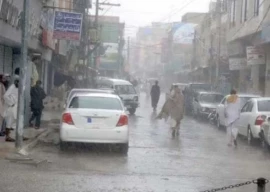
In Greenland, Alaska and Siberia, permafrost is melting at an alarming rate, transforming once-frozen soil into wetlands. And vanishing glaciers are stripping snow caps on the mountain tops. These overhead water tanks of nature discharge water into the sea at such an alarming rate that some islands in the Maldives may be submerged 50 years from now, and in many countries once fertile lands are turning into deserts.
Dr Viner from the Climatic Research Unit at the University of East Anglia points out that nine of the 10 warmest years on record occurred in the last decade and the 2003 July-August heat wave caused over 25,000 deaths in Europe alone, according to the World Health Organisation (WHO). In the same year the world was shocked to hear that a huge chunk of ‘eternal’ ice had broken off Switzerland’s iconic Mount Matterhorn. The cause: excessive heat surrounding the mountain’s external wall.
Mountainous Switzerland has been experiencing phenomenally hot weather since 2003. The Alpine area as a whole receives 100 million visitors every year. According to a case study, “The trend for shorter, more frequent holiday breaks has enabled a greater use of ski areas than ever before. The pressure of human activities, as well as the effects of climate change and global warming on the physical landscape will inevitably affect the environment. The Alpine region needs to utilise sustainable development strategies in order to control the impact on its environment”. Local environmentalists are concerned that Switzerland’s skiing season will become shorter as many low-lying ski resorts in Alpine regions are vulnerable to simultaneous reduction in snowfall and an increase in winter tourism activities.
Aware of the potential environmentalist backlash, mountain villages in Switzerland have begun to ballyhoo their green credentials to encourage climate-conscious visitors to the Alps.
As one such visitor (and a frequent one at that), I can’t travel the region without being stunned by the grandeur of the Matterhorn, which is regarded as the most photogenic mountain in the European Alps.
I have shot the Matterhorn from various perspectives and yet, each time I see this illustrious sculpture of nature, I am unable to resist its hypnotic appeal and keep clicking until the peak is out of sight after dusk. But recently this appeal carries a sense of concern as I see the upper crust of the mountain stripped of its thick coat of ice and a shrinking glacier at the base of the Matterhorn.
Today, Zermatt is one of the world’s top ski resorts and one of Europe’s most visited mountain areas. Although the centre of Zermatt has lost its ‘village’ appeal, the valley is still a car-free zone except for a few green-powered buggies zipping around the narrow streets.
In winter, visitors can opt for skiing, snowboarding, liquid trailing and ice climbing or just wander around taking the many motorised cableways or mountain rails to higher ground.
Visitors not geared for trekking in the cold opt to hop from one railway to the other. Even the trains run on ‘green energy’. The Matterhorn Gotthard Bahn and the Gornergrat Bahn offer routes between Disentis and the Gornergrat in the highlands of Zermatt. The cogwheel train meanders 30 minutes from Zermatt to the Gornergrat. It’s rewarding to stay overnight at the 3100 Kulmhotel Gornergrat to experience the countdown to one of nature’s most spectacular displays as the peaks are swathed in gold at daybreak.
And in the summer, refreshing hiking trails through green pastures lead to the many lakes and water pools that reflect the lofty peaks in clear, mineral-rich water. The whole valley blooms in a medley of colors. Visitors can opt for a number of eco-friendly tourist activities. The Matterhorn Gotthard Bahn will transport bicycles and their riders to Oberwald — the picturesque starting point of the pleasant bike tour along the river Rhone.
Will these scenic wonders, which in truth belong to all
humanity, survive the disastrous damage we are causing to the
environment?
Published in The Express Tribune, Sunday Magazine, March 27th, 2011.























COMMENTS
Comments are moderated and generally will be posted if they are on-topic and not abusive.
For more information, please see our Comments FAQ